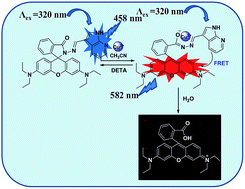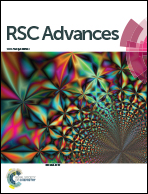Chemodosimeter approach for nanomolar detection of Cu2+ ions and their bio-imaging in PC3 cell lines†
Abstract
A new rhodamine–azaindole based receptor 4 has been synthesized which selectively senses Cu2+ ions via a fluorescence resonance energy transfer (FRET) process in acetonitrile while in mixed aqueous media it undergoes Cu2+ promoted hydrolysis among the various metal ions tested (Pb2+, Ba2+, Fe3+, Cd2+, Ag+, Zn2+, Hg2+, Cu2+, Ni2+, Co2+, Fe2+ and Mg2+). The time resolved fluorescence studies also support the Cu2+ promoted hydrolysis of receptor 4 in mixed aqueous media. The detection limit for Cu2+ ions has been found to be 20 nM. The potential biological application of probe 4 is evaluated for in vitro detection of copper ions in prostate cancer (PC3) cell lines.


 Please wait while we load your content...
Please wait while we load your content...